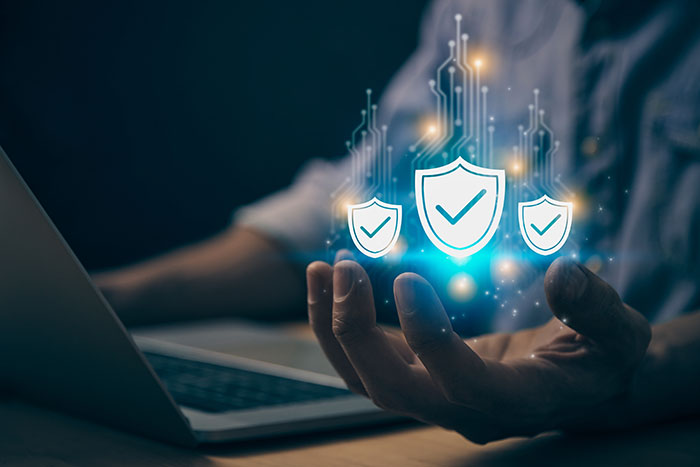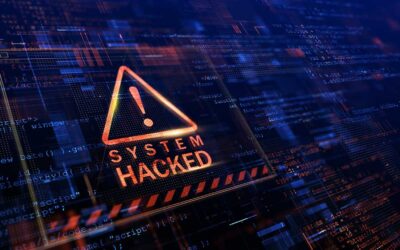Cybersecurity solutions defend against cyber threats, protecting your IT infrastructure, data, and overall business operations. These solutions encompass various tools and services designed to mitigate the impact of cyber attacks, such as:
Application Security
Application security focuses on securing software applications from development to deployment. It involves practices like secure coding, regular code reviews, and rigorous testing to identify and fix vulnerabilities before attackers can exploit them. Tools used in application security include static application security testing (SAST) and dynamic application security testing (DAST), which help identify security issues in the code and the running application, respectively.
Cloud Security
Cloud security ensures the security of public, private, and hybrid cloud deployments. As businesses increasingly move to the cloud, securing these environments becomes crucial. Cloud security involves strategies and tools to protect data, applications, and infrastructure in the cloud. Key aspects include data encryption, identity and access management (IAM), and regular security assessments to ensure compliance with standards like GDPR and HIPAA.
Endpoint Security
Endpoint security protects devices like laptops, smartphones, and tablets from malware and unauthorized access. With the rise of remote work and BYOD (bring your own device) policies, securing endpoints has become more critical. Endpoint security solutions include antivirus software, endpoint detection and response (EDR) tools, and mobile device management (MDM) systems, which help monitor and manage the security of all devices connected to the corporate network.
Network Security
Network security monitors and protects network traffic against malicious activities. It involves using firewalls, intrusion detection systems (IDS), intrusion prevention systems (IPS), and virtual private networks (VPNs) to secure network infrastructure. Network security aims to protect data in transit, prevent unauthorized access, and detect and respond to network-based attacks.
IoT Security
IoT security secures interconnected devices that store and process sensitive data. The Internet of Things (IoT) brings significant benefits but also introduces new security challenges. IoT security involves securing devices, communication channels, and data exchanged between devices. It includes practices like secure firmware updates, device authentication, and network segmentation to prevent unauthorized access.
Key Cybersecurity Services
In addition to the tools mentioned above, key cybersecurity services include:
- Vulnerability Assessments: Identify and prioritize vulnerabilities in your IT environment.
- Penetration Testing: Simulate attacks to test the effectiveness of your security measures.
- Threat Detection: Monitor for and identify potential security threats in real-time.
- Access Management: Control and monitor user access to sensitive information and systems.
- Incident Response Planning: Develop and implement plans to respond to security incidents.
- User Awareness Training: Educate employees on cybersecurity best practices and threat awareness.
Steps to Choose the Right Cybersecurity Solution
Conduct an Internal Cybersecurity Risk Assessment
- Evaluate Your Business:
- Assess factors like company size, industry, and geographical presence.
- Consider industry-specific threats and regulatory requirements.
- Forecast Future Changes:
- Anticipate potential changes in your organization that may impact cybersecurity needs.
- Plan for business growth, mergers, or new technology adoption.
- Assess Existing Resources:
- Determine whether to develop in-house cybersecurity strategies or outsource.
- Evaluate the current skills and resources of your IT team.
- Determine Risk Tolerance:
- Understand the potential impact of cyber attacks and your resources for response.
- Decide on acceptable levels of risk for different types of data and operations.
Determine Your Cybersecurity Solution Needs
- Data Handling:
- Identify the types of data stored and their sensitivity.
- Consider personal data, financial information, intellectual property, and other sensitive data.
- Protection Level:
- Assess the level of protection needed based on identified threats.
- Consider the potential consequences of data breaches and other security incidents.
- Budget and Timescale:
- Establish a budget and timeline for implementing cybersecurity solutions.
- Balance the need for security with financial constraints and business priorities.
- Market Evaluation:
- Compare available solutions based on features and alignment with your needs.
- Look for solutions that offer comprehensive protection and can integrate with existing systems.
- Training Resources:
- Determine the need for staff training in cybersecurity practices.
- Ensure that employees are aware of security policies and can recognize potential threats.
Partner with Cybersecurity Solution Providers
- Features and Services:
- Ensure the provider offers solutions that meet your current and future needs.
- Look for providers with a wide range of services, including threat intelligence, managed security services, and incident response.
- Reputation:
- Research reviews, testimonials, and certifications to gauge reliability.
- Consider the provider’s track record, customer support, and industry expertise.
- Compliance:
- Verify that the provider adheres to industry regulations and standards.
- Ensure the solution supports compliance with regulations such as GDPR, HIPAA, and PCI DSS.
Justify the Costs
- Budget Constraints:
- Balance cost with the value of the solution’s protection and support.
- Consider total cost of ownership, including initial setup, maintenance, and potential savings from preventing security incidents.
- Long-term Investment:
- Consider the ongoing investment in cybersecurity beyond initial costs.
- Evaluate the long-term benefits of enhanced security, including reduced risk of breaches and potential cost savings from incident response and recovery.
Scalability and User-friendliness
- Scalability:
- Ensure the solution can grow and adapt with your business.
- Look for flexible solutions that can scale with increased data volume, user count, and evolving threats.
- User-friendliness:
- Select a solution with an intuitive interface for ease of use by all employees.
- Ensure the solution includes user-friendly dashboards, clear reporting, and accessible support.
Evaluating the Cyber Threat Landscape
Understanding the cyber threat landscape is crucial for selecting the right cybersecurity solution. This involves staying informed about the latest threats, attack vectors, and tactics used by cybercriminals. By doing so, businesses can tailor their cybersecurity strategies to address the most relevant threats.
- Types of Cyber Threats:
- Malware: Malicious software designed to damage or disrupt systems, steal data, or perform other harmful actions. Common types include viruses, worms, ransomware, and spyware.
- Phishing: Deceptive attempts to obtain sensitive information by masquerading as a trustworthy entity in electronic communications.
- DDoS Attacks: Distributed Denial of Service attacks overwhelm a network or website with traffic, causing it to become unavailable to legitimate users.
- Insider Threats: Malicious or negligent actions by employees, contractors, or other insiders that compromise security.
- Monitoring Threat Intelligence:
- Subscribe to threat intelligence feeds and services to receive real-time updates on emerging threats.
- Use threat intelligence platforms to analyze and correlate data from multiple sources, enhancing situational awareness.
- Assessing Industry-specific Risks:
- Different industries face unique cyber threats based on their operations, data handling, and regulatory requirements.
- Conduct industry benchmarking to understand common vulnerabilities and best practices.
Implementing a Layered Security Approach
A layered security approach, also known as defense in depth, involves using multiple security measures to protect different aspects of the IT environment. This strategy ensures that if one layer is compromised, others remain intact to prevent a full-scale breach.
- Perimeter Security:
- Use firewalls, IDS/IPS, and secure gateways to protect the network boundary.
- Implement network segmentation to isolate critical systems and data.
- Endpoint Protection:
- Deploy EDR solutions to monitor and respond to threats on endpoints.
- Use encryption and data loss prevention (DLP) tools to safeguard sensitive information on devices.
- Application Security:
- Incorporate secure coding practices and regular security testing in the software development lifecycle.
- Use web application firewalls (WAF) to protect against web-based attacks.
- Identity and Access Management:
- Implement multi-factor authentication (MFA) to verify user identities.
- Use role-based access control (RBAC) to limit access to sensitive data and systems.
- Data Security:
- Encrypt data at rest and in transit to protect it from unauthorized access.
- Implement robust backup and recovery solutions to ensure data integrity and availability.
Developing an Incident Response Plan
An effective incident response plan is essential for minimizing the impact of cyber incidents and ensuring a swift recovery. This plan should outline the procedures for detecting, responding to, and recovering from security incidents.
- Preparation:
- Establish an incident response team with defined roles and responsibilities.
- Develop and document incident response policies and procedures.
- Detection and Analysis:
- Use SIEM (Security Information and Event Management) systems to monitor and analyze security events.
- Define clear criteria for identifying and classifying incidents.
- Containment, Eradication, and Recovery:
- Develop strategies for containing the spread of an incident and preventing further damage.
- Eradicate the root cause of the incident and restore affected systems to normal operation.
- Conduct a thorough post-incident analysis to identify lessons learned and improve response capabilities.
- Communication:
- Establish communication protocols for informing stakeholders, including employees, customers, and regulators.
- Use predefined templates for incident notifications and updates.
Ensuring Compliance and Regulatory Adherence
Compliance with industry regulations and standards is a critical aspect of cybersecurity. Non-compliance can result in significant financial penalties and reputational damage.
- Understanding Regulatory Requirements:
- Identify relevant regulations and standards based on your industry and geographical location. Common examples include GDPR, HIPAA, PCI DSS, and CCPA.
- Understand the specific security controls and measures required to achieve compliance.
- Implementing Compliance Controls:
- Develop and implement policies and procedures that address regulatory requirements.
- Use compliance management tools to monitor and report on adherence to standards.
- Regular Audits and Assessments:
- Conduct regular internal audits and assessments to ensure ongoing compliance.
- Engage third-party auditors to validate compliance and identify areas for improvement.
- Documentation and Reporting:
- Maintain detailed records of compliance activities, including risk assessments, control implementations, and incident responses.
- Use automated tools to generate compliance reports and dashboards for stakeholders.
Building a Security-focused Culture
Creating a security-focused culture within your organization is essential for effective cybersecurity. This involves fostering an environment where employees are aware of security risks and take proactive measures to protect the organization.
- Employee Training and Awareness:
- Conduct regular training sessions on cybersecurity best practices and threat awareness.
- Use simulated phishing exercises to test and improve employees’ ability to recognize and respond to phishing attempts.
- Leadership and Governance:
- Ensure that senior leadership prioritizes cybersecurity and allocates adequate resources.
- Establish a cybersecurity governance framework with defined roles and responsibilities.
- Encouraging Security Best Practices:
- Promote a culture of security by recognizing and rewarding employees who demonstrate good security practices.
- Encourage employees to report suspicious activities and potential security incidents.
- Continuous Improvement:
- Regularly review and update security policies and procedures to address evolving threats and changes in the business environment.
- Use feedback from security incidents and training exercises to improve the organization’s security posture.
Leveraging Advanced Technologies and Innovations
Emerging technologies and innovations can enhance your cybersecurity efforts and provide more robust protection against advanced threats. Staying informed about and adopting these technologies can help your business stay ahead of cybercriminals.
- Artificial Intelligence and Machine Learning:
- Use AI and ML to detect and respond to threats in real-time.
- Implement behavior analysis to identify anomalies and potential threats.
- Automation and Orchestration:
- Automate repetitive security tasks to improve efficiency and reduce the risk of human error.
- Use security orchestration to coordinate responses across multiple security tools and systems.
- Blockchain Technology:
- Leverage blockchain for secure data storage and transaction verification.
- Use blockchain-based identity management solutions to enhance access control.
- Zero Trust Architecture:
- Adopt a zero trust approach to security, where no user or device is trusted by default, even if they are within the network perimeter.
- Implement continuous verification and least privilege access principles.
- Quantum Cryptography:
- Prepare for the future of quantum computing by exploring quantum-resistant cryptographic algorithms.
- Invest in research and development to stay ahead of potential quantum threats.
Understanding Cybersecurity Frameworks
Cybersecurity frameworks provide structured guidelines to help organizations implement and manage their security practices effectively. Familiarizing yourself with these frameworks can aid in creating a comprehensive cybersecurity strategy.
- NIST Cybersecurity Framework:
- Developed by the National Institute of Standards and Technology, this framework provides a policy framework of computer security guidance for how private sector organizations can assess and improve their ability to prevent, detect, and respond to cyber attacks.
- It consists of five core functions: Identify, Protect, Detect, Respond, and Recover.
- ISO/IEC 27001:
- An international standard for information security management systems (ISMS). It provides a systematic approach to managing sensitive company information so that it remains secure.
- The framework includes requirements for establishing, implementing, maintaining, and continually improving an ISMS.
- CIS Controls:
- Developed by the Center for Internet Security, these are a set of best practices for securing IT systems and data against cyber threats.
- The CIS Controls are divided into three categories: Basic, Foundational, and Organizational, which cover key aspects like inventory and control of hardware and software assets, continuous vulnerability management, and incident response management.
- COBIT (Control Objectives for Information and Related Technologies):
- A framework created by ISACA for IT management and IT governance. It helps organizations develop, organize, and implement strategies around information management and governance.
- COBIT emphasizes regulatory compliance, risk management, and aligning IT strategy with organizational goals.
Prioritizing Threat Detection and Response
Effective threat detection and response are critical components of a robust cybersecurity strategy. These practices help organizations identify and mitigate threats before they can cause significant damage.
- Setting Up Monitoring Systems:
- Use SIEM (Security Information and Event Management) systems to aggregate and analyze activity from various resources across your IT infrastructure.
- Implement network monitoring tools to continuously scan for unusual activity that could indicate a security incident.
- Establishing Incident Response Protocols:
- Develop a detailed incident response plan that outlines specific steps to take when a threat is detected.
- Train your incident response team to handle different types of security incidents, ensuring they can act quickly and effectively.
- Utilizing Threat Intelligence:
- Subscribe to threat intelligence services to stay informed about the latest cyber threats and vulnerabilities.
- Integrate threat intelligence into your security operations to enhance your ability to detect and respond to emerging threats.
- Regular Testing and Drills:
- Conduct regular penetration testing and red team exercises to evaluate the effectiveness of your security measures.
- Organize incident response drills to ensure your team is prepared to handle real-world cyber attacks.
Enhancing Data Protection and Privacy
Implementing strong data protection measures helps safeguard sensitive information and maintain customer trust.
- Data Encryption:
- Encrypt data both at rest and in transit to protect it from unauthorized access and breaches.
- Use advanced encryption standards (AES) to ensure data remains secure and inaccessible to unauthorized users.
- Access Controls:
- Implement strict access controls to limit who can access sensitive data. Use principles like least privilege and need-to-know basis to restrict access.
- Use IAM (Identity and Access Management) solutions to manage user identities and control access to critical resources.
- Data Masking:
- Use data masking techniques to hide sensitive data within databases, making it accessible only to authorized users.
- Implement pseudonymization and anonymization methods to protect personal data in compliance with privacy regulations.
- Regular Audits and Assessments:
- Conduct regular data protection audits to ensure compliance with internal policies and external regulations.
- Use data loss prevention (DLP) tools to monitor, detect, and prevent potential data breaches.
Building a Cybersecurity Incident Response Team (CIRT)
Having a dedicated Cybersecurity Incident Response Team (CIRT) is crucial for effectively managing and responding to security incidents. This team plays a pivotal role in protecting the organization’s assets and ensuring quick recovery from incidents.
- Defining Roles and Responsibilities:
- Clearly define the roles and responsibilities of each team member, ensuring they understand their specific tasks during an incident.
- Include roles such as incident commander, communications officer, technical lead, and forensic analyst.
- Developing Response Procedures:
- Create detailed procedures for common types of incidents, such as data breaches, malware infections, and phishing attacks.
- Ensure procedures are documented and easily accessible to all team members.
- Training and Certification:
- Provide regular training and certification opportunities for CIRT members to keep their skills up to date.
- Encourage participation in cybersecurity conferences and workshops to stay informed about the latest threats and response techniques.
- Collaboration and Communication:
- Foster collaboration between the CIRT and other departments, such as IT, legal, and PR, to ensure a coordinated response.
- Establish clear communication channels for reporting incidents and providing updates during an incident.
Strengthening Third-party Vendor Security
Many organizations rely on third-party vendors for various services and technologies. Ensuring these vendors adhere to strong cybersecurity practices is essential for maintaining overall security.
- Conducting Vendor Risk Assessments:
- Evaluate the cybersecurity practices of potential vendors before entering into a partnership.
- Use standardized questionnaires and frameworks to assess vendor security posture.
- Establishing Security Requirements:
- Define specific security requirements and expectations in vendor contracts.
- Include clauses related to data protection, incident reporting, and compliance with relevant regulations.
- Monitoring Vendor Compliance:
- Implement processes for continuous monitoring of vendor compliance with security requirements.
- Use third-party risk management (TPRM) tools to automate and streamline vendor assessments.
- Incident Response Coordination:
- Ensure vendors have incident response plans in place and are willing to coordinate with your organization during a security incident.
- Establish clear communication channels for reporting and managing incidents involving third-party vendors.
Picking the Best Cybersecurity Solution Option
Choosing the right cybersecurity solution for your business is a critical decision that requires careful consideration of various factors. By understanding the types of cybersecurity solutions available, assessing your specific needs, and partnering with reputable providers, you can enhance your business’s security posture and protect against evolving cyber threats. Conducting thorough risk assessments, planning for future changes, and balancing costs with benefits will ensure that you select a solution that not only meets your current needs but also supports your business’s growth and resilience in the face of cyber risks.
Remember, cybersecurity is not a one-time effort but an ongoing process that requires continuous monitoring, updating, and training to stay ahead of threats. Investing in the right cybersecurity solution today can save your business from significant financial and reputational damage in the future.




